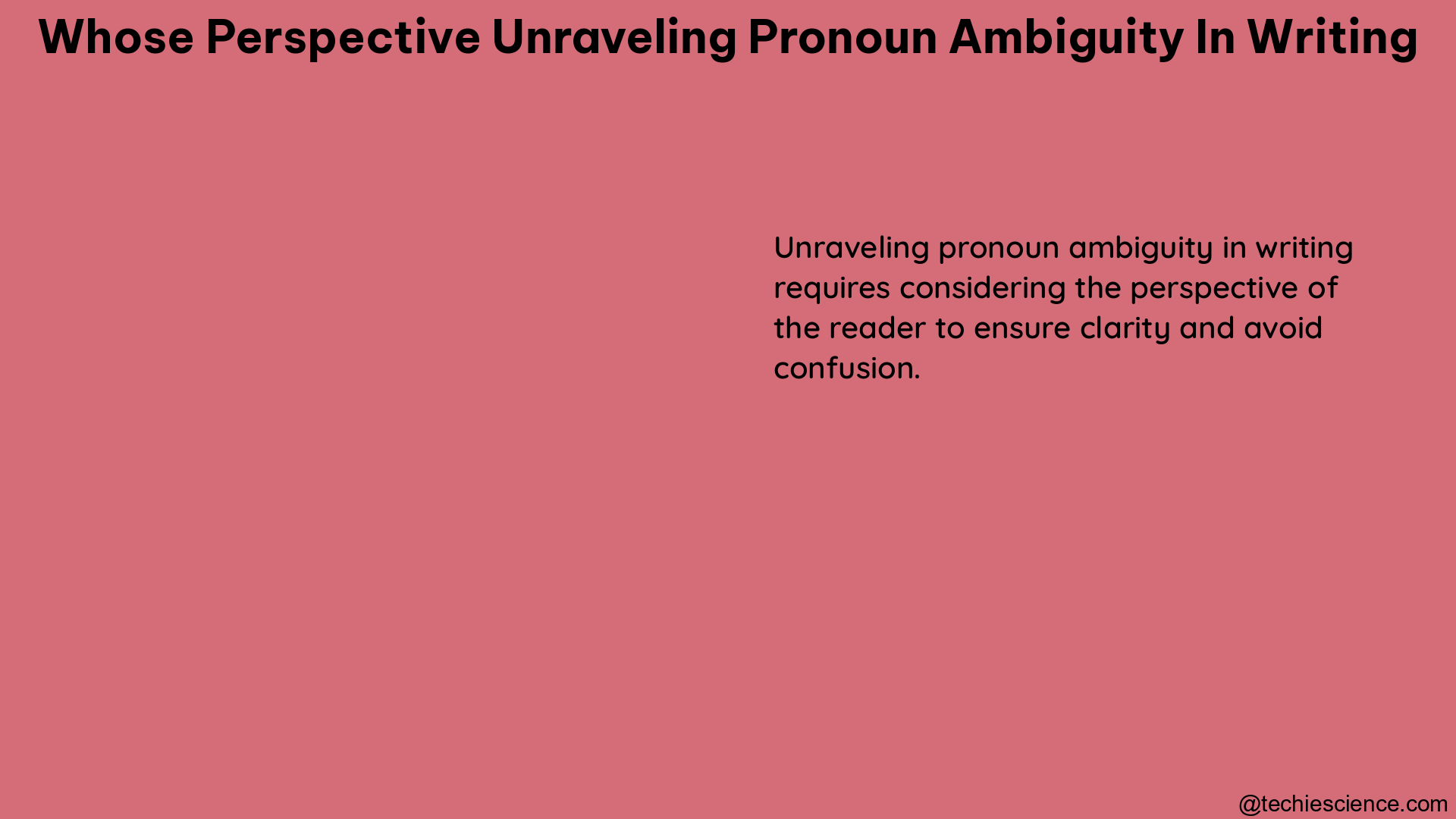Unraveling pronoun ambiguity in writing is a crucial skill for any aspiring writer or student of English. Pronouns, while essential for creating cohesive and concise prose, can often lead to confusion when their antecedents are unclear. In this comprehensive guide, we will explore the various types of pronoun ambiguity, provide practical resolution techniques, and delve into advanced methods for ensuring clarity in your writing.
Understanding Pronoun Ambiguity
Pronoun ambiguity arises when a pronoun can refer to multiple possible antecedents, leaving the reader unsure of the intended meaning. This can occur in various forms, including:
Ambiguous Pronouns
These are pronouns with multiple possible antecedents, making it unclear which noun they refer to. For example:
“Lan and his father went to see his favorite movie.” (Could refer to Lan or his father)
“The girls and the boys went down to the lake, which was her favorite place.” (Could refer to one of the girls)
Implied/Missing Pronouns
This occurs when a possessive adjective is used instead of a pronoun, leading to a lack of clarity. For instance:
“In Virginia Woolf’s Mrs. Dalloway, she explores the limits of modernism.” (Should be “Virginia Woolf explores”)
Vague Pronouns
Vague pronouns are those with no clear antecedent, leaving the reader unsure of the intended reference. For example:
“As nursing requires a high level of skill, they should receive correspondingly high salaries.” (Unclear who “they” refers to)
Resolving Pronoun Ambiguity

To effectively resolve pronoun ambiguity, writers can employ various techniques:
Rearrange the Sentence
Clarify the antecedent by rearranging the sentence structure. For example:
“Bob and Gary ran for the house, zombies crashing through the woods behind them.” (Unclear who tripped)
Revised: “Get to the car!” Bob screamed, reloading the shotgun while Gary dug into his pockets for the keys. He tripped and went flying, slamming against the dirt with a grunt.”
Use Names Instead of Pronouns
Replace pronouns with names to avoid ambiguity. This can be particularly helpful when dealing with multiple subjects or characters.
Add Context
Provide additional context to disambiguate the pronoun and clarify its intended reference.
Advanced Techniques
While the above methods are effective in resolving basic pronoun ambiguity, there are more advanced techniques that can be employed:
Cross-Linguistic Analysis
Utilizing information from multiple languages can help resolve ambiguity. For instance, some languages have grammatical gender that can provide clues about pronoun reference.
Probabilistic Models
Statistical methods can be used to predict the likelihood of various interpretations, aiding in the resolution of ambiguous pronouns.
Future Directions
As the field of natural language processing (NLP) continues to evolve, researchers are exploring innovative approaches to address pronoun ambiguity:
Context-Aware Algorithms
Developing systems that can interpret language with greater precision by considering contextual information, such as the surrounding text, speaker/writer, and cultural references.
Multimodal Models
Integrating NLP with other AI domains, like computer vision, to provide additional context clues and improve the understanding of language.
Interactive Approaches
Systems that can engage in a dialogue with users, asking clarifying questions or using feedback loops to refine their understanding of language in real-time.
Conclusion
Unraveling pronoun ambiguity is a crucial skill for writers, students, and anyone who aims to communicate effectively. By understanding the various types of pronoun errors, mastering resolution techniques, and staying informed about the latest advancements in the field, you can elevate your writing and ensure your message is conveyed with clarity and precision.
References
- Magoosh. (2021). Identifying and Fixing Ambiguous Pronouns on the ACT. Retrieved from https://magoosh.com/hs/act/ambiguous-pronoun/
- Hardy, J. (2010). I Had to Do This: Clarifying Ambiguous Pronouns. Retrieved from http://blog.janicehardy.com/2010/05/re-write-wednesday-i-had-to-do-this.html
- Study.com. (n.d.). Ambiguous Pronoun | Definition, Identification & Examples. Retrieved from https://study.com/learn/lesson/ambiguous-pronoun-definition-examples.html
- Shelf.io. (n.d.). Decipher Ambiguity in NLP Systems for Sharper AI Intelligence. Retrieved from https://shelf.io/blog/ambiguity-in-nlp-systems/
- Swarthmore College. (n.d.). Pronoun Reference. Retrieved from https://www.swarthmore.edu/writing/pronoun-reference-0

The lambdageeks.com Core SME Team is a group of experienced subject matter experts from diverse scientific and technical fields including Physics, Chemistry, Technology,Electronics & Electrical Engineering, Automotive, Mechanical Engineering. Our team collaborates to create high-quality, well-researched articles on a wide range of science and technology topics for the lambdageeks.com website.
All Our Senior SME are having more than 7 Years of experience in the respective fields . They are either Working Industry Professionals or assocaited With different Universities. Refer Our Authors Page to get to know About our Core SMEs.